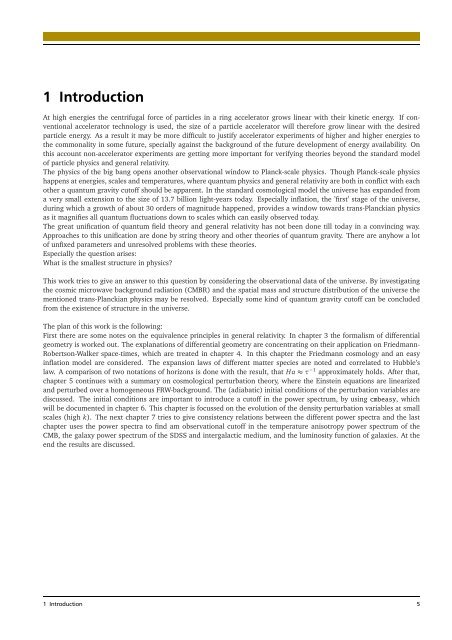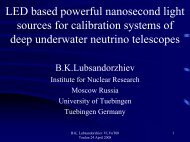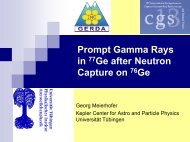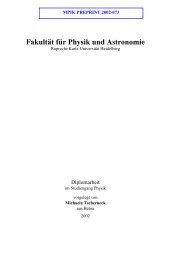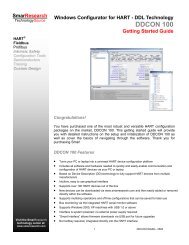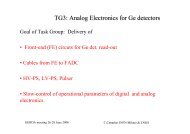Master Thesis
Master Thesis
Master Thesis
You also want an ePaper? Increase the reach of your titles
YUMPU automatically turns print PDFs into web optimized ePapers that Google loves.
1 Introduction<br />
At high energies the centrifugal force of particles in a ring accelerator grows linear with their kinetic energy. If conventional<br />
accelerator technology is used, the size of a particle accelerator will therefore grow linear with the desired<br />
particle energy. As a result it may be more difficult to justify accelerator experiments of higher and higher energies to<br />
the commonality in some future, specially against the background of the future development of energy availability. On<br />
this account non-accelerator experiments are getting more important for verifying theories beyond the standard model<br />
of particle physics and general relativity.<br />
The physics of the big bang opens another observational window to Planck-scale physics. Though Planck-scale physics<br />
happens at energies, scales and temperatures, where quantum physics and general relativity are both in conflict with each<br />
other a quantum gravity cutoff should be apparent. In the standard cosmological model the universe has expanded from<br />
a very small extension to the size of 13.7 billion light-years today. Especially inflation, the ’first’ stage of the universe,<br />
during which a growth of about 30 orders of magnitude happened, provides a window towards trans-Planckian physics<br />
as it magnifies all quantum fluctuations down to scales which can easily observed today.<br />
The great unification of quantum field theory and general relativity has not been done till today in a convincing way.<br />
Approaches to this unification are done by string theory and other theories of quantum gravity. There are anyhow a lot<br />
of unfixed parameters and unresolved problems with these theories.<br />
Especially the question arises:<br />
What is the smallest structure in physics?<br />
This work tries to give an answer to this question by considering the observational data of the universe. By investigating<br />
the cosmic microwave background radiation (CMBR) and the spatial mass and structure distribution of the universe the<br />
mentioned trans-Planckian physics may be resolved. Especially some kind of quantum gravity cutoff can be concluded<br />
from the existence of structure in the universe.<br />
The plan of this work is the following:<br />
First there are some notes on the equivalence principles in general relativity. In chapter 3 the formalism of differential<br />
geometry is worked out. The explanations of differential geometry are concentrating on their application on Friedmann-<br />
Robertson-Walker space-times, which are treated in chapter 4. In this chapter the Friedmann cosmology and an easy<br />
inflation model are considered. The expansion laws of different matter species are noted and correlated to Hubble’s<br />
law. A comparison of two notations of horizons is done with the result, that Ha≈τ −1 approximately holds. After that,<br />
chapter 5 continues with a summary on cosmological perturbation theory, where the Einstein equations are linearized<br />
and perturbed over a homogeneous FRW-background. The (adiabatic) initial conditions of the perturbation variables are<br />
discussed. The initial conditions are important to introduce a cutoff in the power spectrum, by usingcmbeasy, which<br />
will be documented in chapter 6. This chapter is focussed on the evolution of the density perturbation variables at small<br />
scales (high k). The next chapter 7 tries to give consistency relations between the different power spectra and the last<br />
chapter uses the power spectra to find am observational cutoff in the temperature anisotropy power spectrum of the<br />
CMB, the galaxy power spectrum of the SDSS and intergalactic medium, and the luminosity function of galaxies. At the<br />
end the results are discussed.<br />
1 Introduction 5


